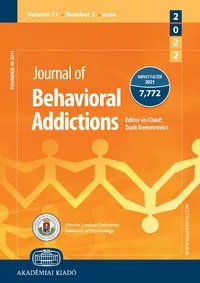Motivational brief interventions for adolescents and young adults with Internet use disorders: A randomized-controlled trial
Motivational brief interventions for adolescents and young adults with Internet use disorders: A randomized-controlled trial
Author(s): Hannah Schmidt, Dominique Brandt, Christian Meyer, Anja Bischof, Gallus Bischof, Anika Trachte, Bettina Besser, Svenja Orlowski, Samantha Schlossarek, Stefan Borgwardt, Hans-Jürgen RumpfSubject(s): Behaviorism
Published by: Akadémiai Kiadó
Keywords: Internet use disorders; brief intervention; motivational interviewing; adolescents; young adults
Summary/Abstract: Background. Adolescents and young adults (AYA) have an increased risk for Internet use disorders (IUD) compared to older individuals that may lead to functional impairments in daily life. To date, evidence-based brief interventions are lacking. This study aimed to test the efficacy of a low-threshold counseling approach based on Motivational Interviewing (MI) in a vocational school setting. Methods. Of 8.230 vocational students (age M=20.56, SD=4.68; 51.85% female) being proactively screened for IUD, 937 with positive screenings took part in telephone-based diagnostic interviews. IUD were assessed in line with the criteria of the Internet Gaming Disorder in the Diagnostic and Statistical Manual of Mental Disorders, 5th edition (DSM-5). Readiness to change, self-efficacy, and impairments in daily life were additionally assessed with standardized screening instruments. Participants fulfilling at least two IUD criteria were randomized to the intervention group (n=240, up to three MI-based counseling sessions via telephone) or the control group (n=257, information brochure on responsible Internet use). Follow-up interviews were conducted after five and ten months. The primary outcome was the reduction of IUD criteria. Secondary outcomes were improvements of readiness/ self-efficacy to change and the reduction of daily impairments. Data were analyzed with Intention-to-Treat (ITT) and complier average causal effect (CACE) analyses. Results. Overall, 153 (63.75%) individuals assigned to the intervention group participated at least in one counseling session (=compliers). Both groups reduced the number of IUD criteria over time. In ITT analyses, however, we did not find intervention effects for primary and secondary outcomes. Bayes statistics were inconclusive. Based on low participation rates in the intervention group, explorative CACE analyses were conducted to compare compliers in the intervention group to potential compliers in the control group. Again, we did not find intervention effects apart from improvements in self-efficacy after five months. Discussion. Telephone-based counseling seems not appropriate to address AYA at risk for IUD. Low participation rates in the intervention group caused underpowered analyses. Besides, dealing with the own Internet use during intensive assessments and receiving an information brochure led to behavioral changes also in the control group. Since the efficacy of brief interventions under the condition of higher participation rates cannot be fully ruled out, further research is required by taking the implications of this study into account.
Journal: Journal of Behavioral Addictions
- Issue Year: 11/2022
- Issue No: 3
- Page Range: 754-765
- Page Count: 12
- Language: English

